NURBN2009 Essay: Health Promotion Program for Children's Nutrition
VerifiedAdded on 2023/04/08
|10
|2050
|350
Essay
AI Summary
This essay analyzes the 'Healthy kids, happy kids' health promotion program, focusing on child nutrition in Donald, Victoria, Australia, and its alignment with the Ottawa Charter for Health Promotion. The assignment explores how the program addresses the charter's six core competencies: building healthy public policy, creating supportive environments, strengthening community action, developing personal skills, reorienting health services, and moving into the future. The essay details the program's strategies for parental education, community empowerment, and healthcare service adjustments to improve children's nutritional status. It emphasizes the importance of empowering parents, fostering community involvement, and reorienting healthcare services to improve nutritional outcomes and ensure long-term health for children. The essay highlights the role of nurses, health literacy, and education in the empowerment of the target population, aiming to enhance children's nutritional well-being.
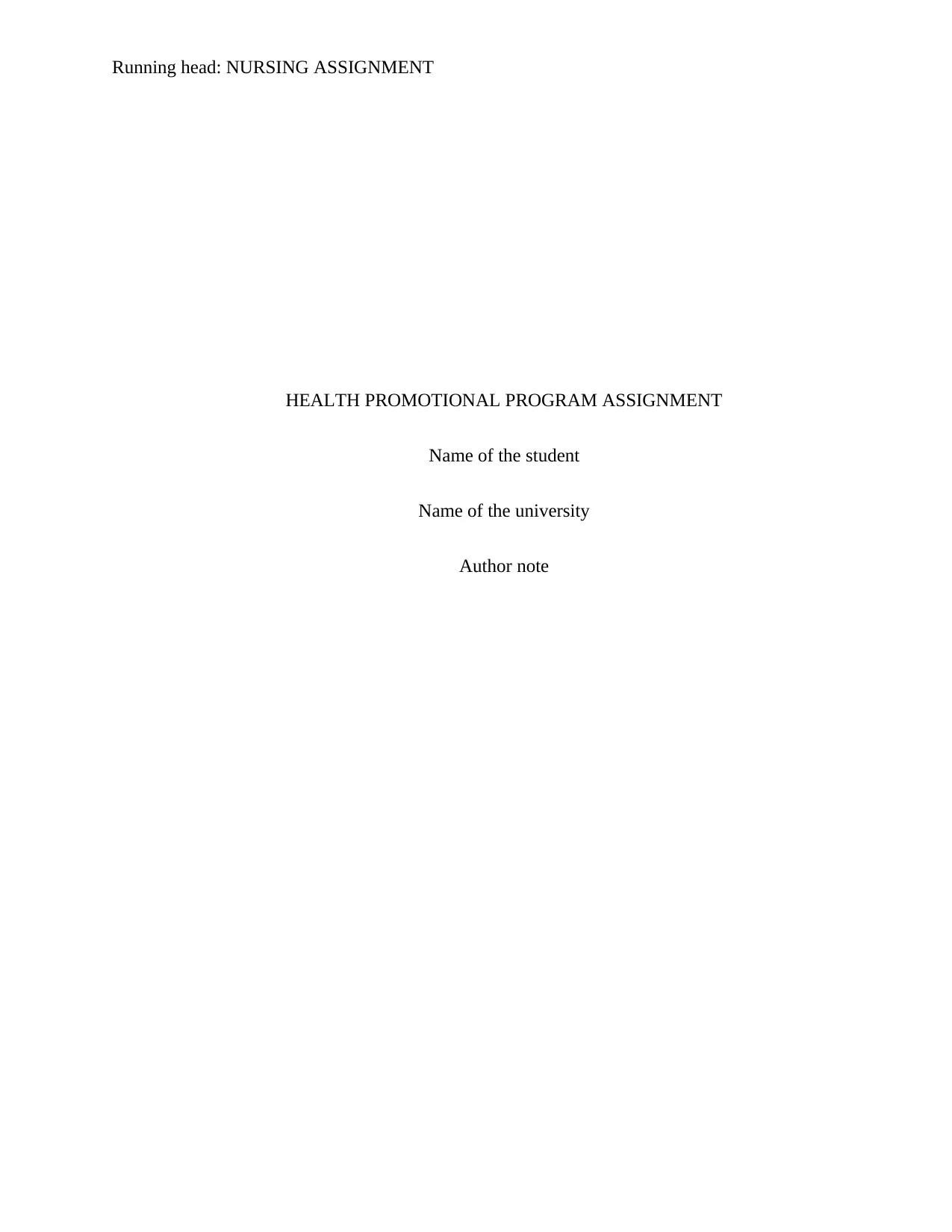
Running head: NURSING ASSIGNMENT
HEALTH PROMOTIONAL PROGRAM ASSIGNMENT
Name of the student
Name of the university
Author note
HEALTH PROMOTIONAL PROGRAM ASSIGNMENT
Name of the student
Name of the university
Author note
Paraphrase This Document
Need a fresh take? Get an instant paraphrase of this document with our AI Paraphraser
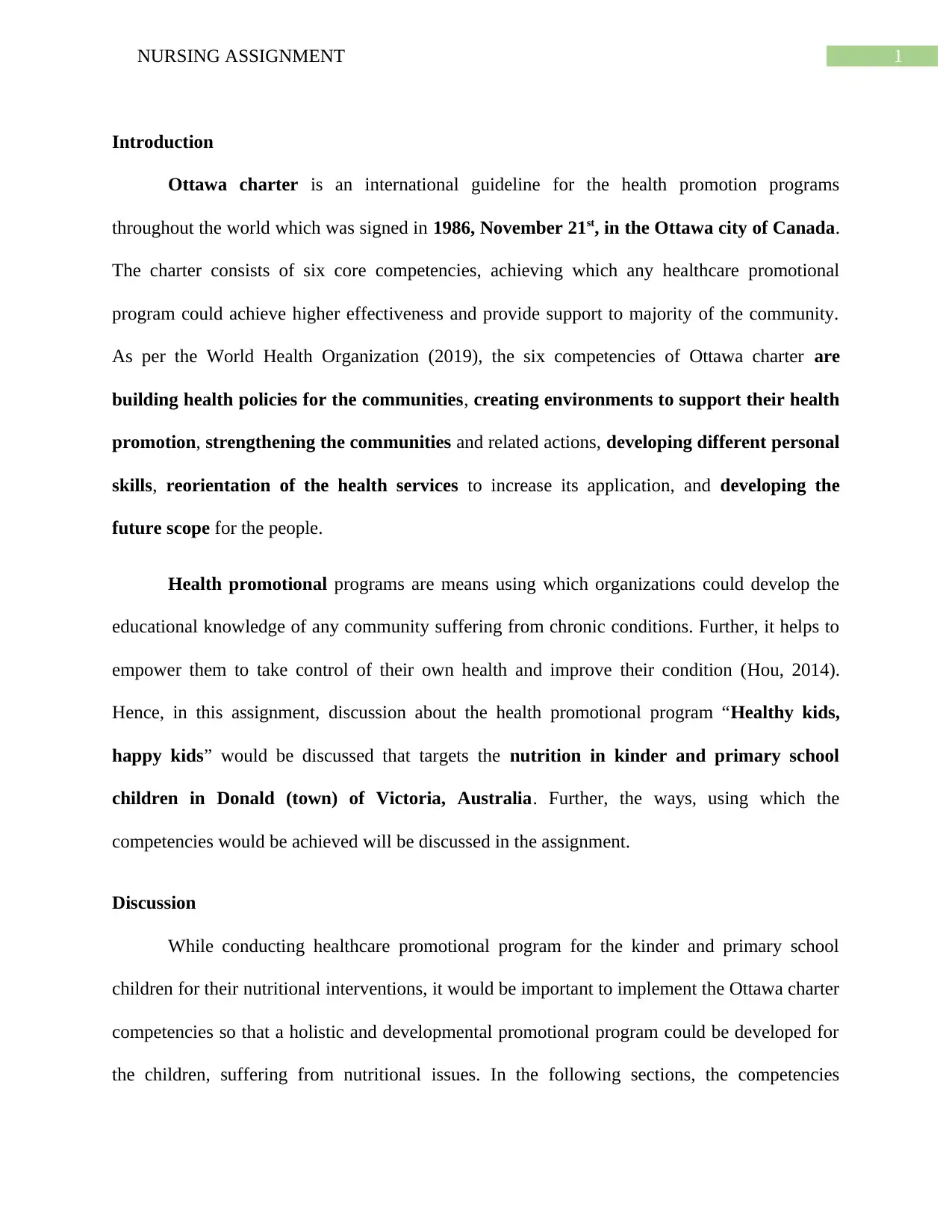
1NURSING ASSIGNMENT
Introduction
Ottawa charter is an international guideline for the health promotion programs
throughout the world which was signed in 1986, November 21st, in the Ottawa city of Canada.
The charter consists of six core competencies, achieving which any healthcare promotional
program could achieve higher effectiveness and provide support to majority of the community.
As per the World Health Organization (2019), the six competencies of Ottawa charter are
building health policies for the communities, creating environments to support their health
promotion, strengthening the communities and related actions, developing different personal
skills, reorientation of the health services to increase its application, and developing the
future scope for the people.
Health promotional programs are means using which organizations could develop the
educational knowledge of any community suffering from chronic conditions. Further, it helps to
empower them to take control of their own health and improve their condition (Hou, 2014).
Hence, in this assignment, discussion about the health promotional program “Healthy kids,
happy kids” would be discussed that targets the nutrition in kinder and primary school
children in Donald (town) of Victoria, Australia. Further, the ways, using which the
competencies would be achieved will be discussed in the assignment.
Discussion
While conducting healthcare promotional program for the kinder and primary school
children for their nutritional interventions, it would be important to implement the Ottawa charter
competencies so that a holistic and developmental promotional program could be developed for
the children, suffering from nutritional issues. In the following sections, the competencies
Introduction
Ottawa charter is an international guideline for the health promotion programs
throughout the world which was signed in 1986, November 21st, in the Ottawa city of Canada.
The charter consists of six core competencies, achieving which any healthcare promotional
program could achieve higher effectiveness and provide support to majority of the community.
As per the World Health Organization (2019), the six competencies of Ottawa charter are
building health policies for the communities, creating environments to support their health
promotion, strengthening the communities and related actions, developing different personal
skills, reorientation of the health services to increase its application, and developing the
future scope for the people.
Health promotional programs are means using which organizations could develop the
educational knowledge of any community suffering from chronic conditions. Further, it helps to
empower them to take control of their own health and improve their condition (Hou, 2014).
Hence, in this assignment, discussion about the health promotional program “Healthy kids,
happy kids” would be discussed that targets the nutrition in kinder and primary school
children in Donald (town) of Victoria, Australia. Further, the ways, using which the
competencies would be achieved will be discussed in the assignment.
Discussion
While conducting healthcare promotional program for the kinder and primary school
children for their nutritional interventions, it would be important to implement the Ottawa charter
competencies so that a holistic and developmental promotional program could be developed for
the children, suffering from nutritional issues. In the following sections, the competencies
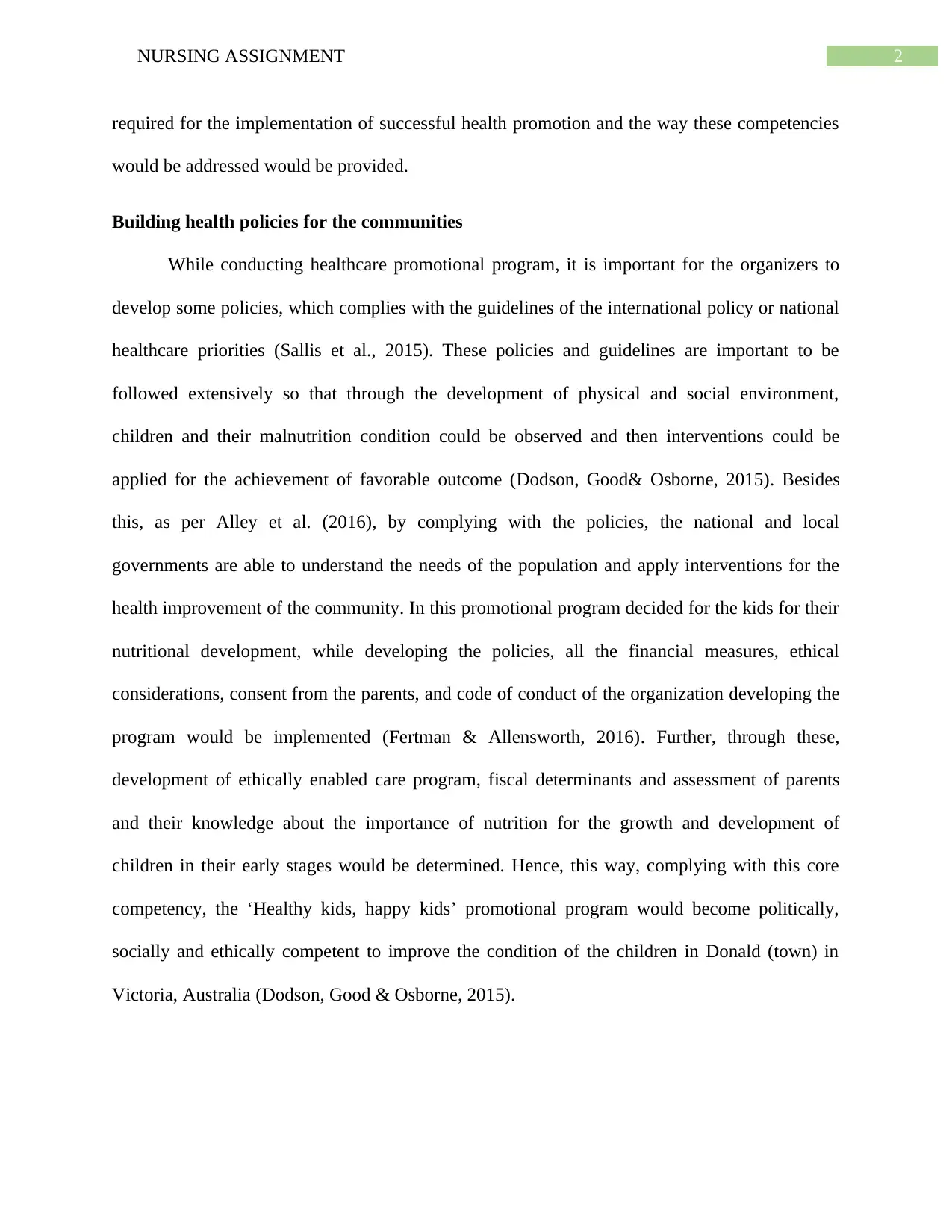
2NURSING ASSIGNMENT
required for the implementation of successful health promotion and the way these competencies
would be addressed would be provided.
Building health policies for the communities
While conducting healthcare promotional program, it is important for the organizers to
develop some policies, which complies with the guidelines of the international policy or national
healthcare priorities (Sallis et al., 2015). These policies and guidelines are important to be
followed extensively so that through the development of physical and social environment,
children and their malnutrition condition could be observed and then interventions could be
applied for the achievement of favorable outcome (Dodson, Good& Osborne, 2015). Besides
this, as per Alley et al. (2016), by complying with the policies, the national and local
governments are able to understand the needs of the population and apply interventions for the
health improvement of the community. In this promotional program decided for the kids for their
nutritional development, while developing the policies, all the financial measures, ethical
considerations, consent from the parents, and code of conduct of the organization developing the
program would be implemented (Fertman & Allensworth, 2016). Further, through these,
development of ethically enabled care program, fiscal determinants and assessment of parents
and their knowledge about the importance of nutrition for the growth and development of
children in their early stages would be determined. Hence, this way, complying with this core
competency, the ‘Healthy kids, happy kids’ promotional program would become politically,
socially and ethically competent to improve the condition of the children in Donald (town) in
Victoria, Australia (Dodson, Good & Osborne, 2015).
required for the implementation of successful health promotion and the way these competencies
would be addressed would be provided.
Building health policies for the communities
While conducting healthcare promotional program, it is important for the organizers to
develop some policies, which complies with the guidelines of the international policy or national
healthcare priorities (Sallis et al., 2015). These policies and guidelines are important to be
followed extensively so that through the development of physical and social environment,
children and their malnutrition condition could be observed and then interventions could be
applied for the achievement of favorable outcome (Dodson, Good& Osborne, 2015). Besides
this, as per Alley et al. (2016), by complying with the policies, the national and local
governments are able to understand the needs of the population and apply interventions for the
health improvement of the community. In this promotional program decided for the kids for their
nutritional development, while developing the policies, all the financial measures, ethical
considerations, consent from the parents, and code of conduct of the organization developing the
program would be implemented (Fertman & Allensworth, 2016). Further, through these,
development of ethically enabled care program, fiscal determinants and assessment of parents
and their knowledge about the importance of nutrition for the growth and development of
children in their early stages would be determined. Hence, this way, complying with this core
competency, the ‘Healthy kids, happy kids’ promotional program would become politically,
socially and ethically competent to improve the condition of the children in Donald (town) in
Victoria, Australia (Dodson, Good & Osborne, 2015).
⊘ This is a preview!⊘
Do you want full access?
Subscribe today to unlock all pages.

Trusted by 1+ million students worldwide
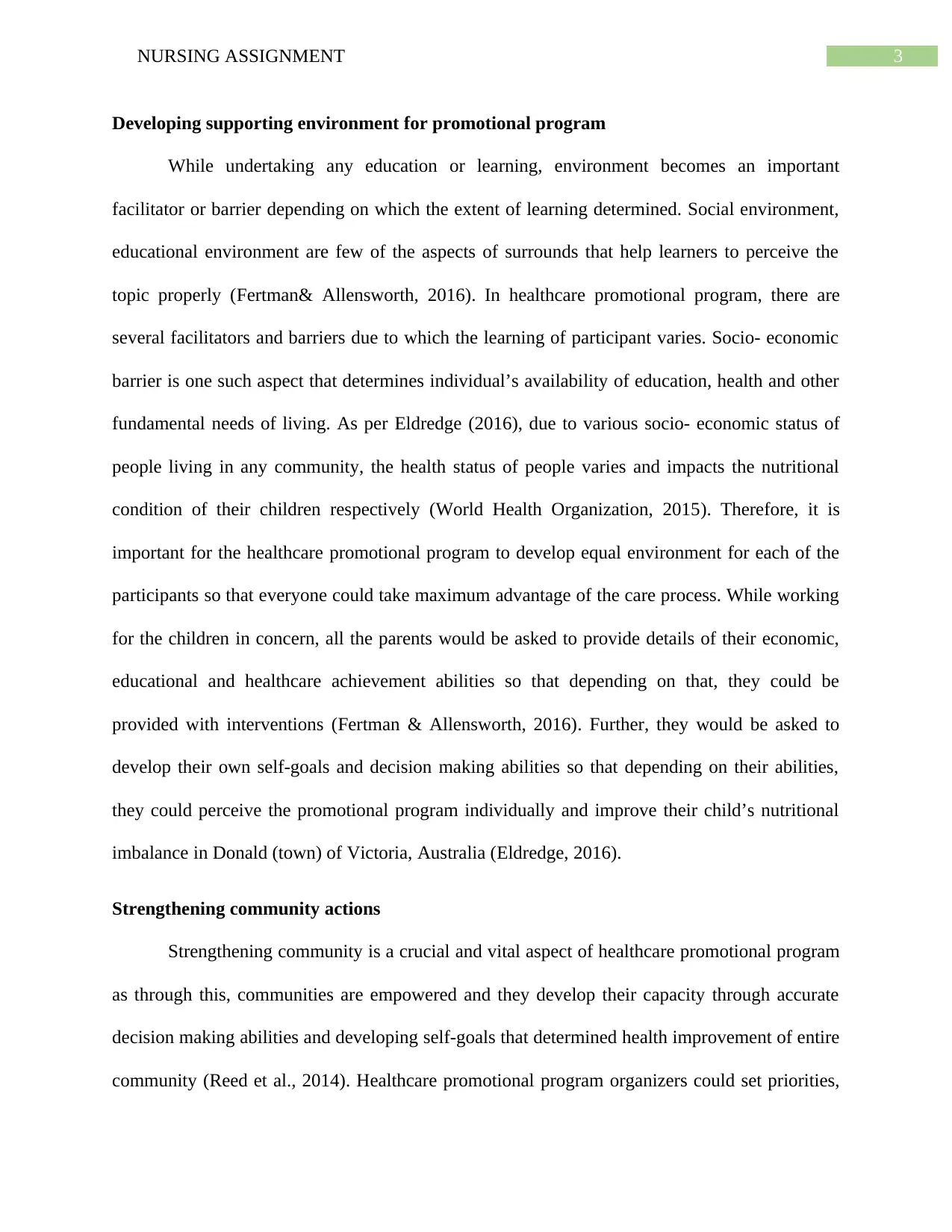
3NURSING ASSIGNMENT
Developing supporting environment for promotional program
While undertaking any education or learning, environment becomes an important
facilitator or barrier depending on which the extent of learning determined. Social environment,
educational environment are few of the aspects of surrounds that help learners to perceive the
topic properly (Fertman& Allensworth, 2016). In healthcare promotional program, there are
several facilitators and barriers due to which the learning of participant varies. Socio- economic
barrier is one such aspect that determines individual’s availability of education, health and other
fundamental needs of living. As per Eldredge (2016), due to various socio- economic status of
people living in any community, the health status of people varies and impacts the nutritional
condition of their children respectively (World Health Organization, 2015). Therefore, it is
important for the healthcare promotional program to develop equal environment for each of the
participants so that everyone could take maximum advantage of the care process. While working
for the children in concern, all the parents would be asked to provide details of their economic,
educational and healthcare achievement abilities so that depending on that, they could be
provided with interventions (Fertman & Allensworth, 2016). Further, they would be asked to
develop their own self-goals and decision making abilities so that depending on their abilities,
they could perceive the promotional program individually and improve their child’s nutritional
imbalance in Donald (town) of Victoria, Australia (Eldredge, 2016).
Strengthening community actions
Strengthening community is a crucial and vital aspect of healthcare promotional program
as through this, communities are empowered and they develop their capacity through accurate
decision making abilities and developing self-goals that determined health improvement of entire
community (Reed et al., 2014). Healthcare promotional program organizers could set priorities,
Developing supporting environment for promotional program
While undertaking any education or learning, environment becomes an important
facilitator or barrier depending on which the extent of learning determined. Social environment,
educational environment are few of the aspects of surrounds that help learners to perceive the
topic properly (Fertman& Allensworth, 2016). In healthcare promotional program, there are
several facilitators and barriers due to which the learning of participant varies. Socio- economic
barrier is one such aspect that determines individual’s availability of education, health and other
fundamental needs of living. As per Eldredge (2016), due to various socio- economic status of
people living in any community, the health status of people varies and impacts the nutritional
condition of their children respectively (World Health Organization, 2015). Therefore, it is
important for the healthcare promotional program to develop equal environment for each of the
participants so that everyone could take maximum advantage of the care process. While working
for the children in concern, all the parents would be asked to provide details of their economic,
educational and healthcare achievement abilities so that depending on that, they could be
provided with interventions (Fertman & Allensworth, 2016). Further, they would be asked to
develop their own self-goals and decision making abilities so that depending on their abilities,
they could perceive the promotional program individually and improve their child’s nutritional
imbalance in Donald (town) of Victoria, Australia (Eldredge, 2016).
Strengthening community actions
Strengthening community is a crucial and vital aspect of healthcare promotional program
as through this, communities are empowered and they develop their capacity through accurate
decision making abilities and developing self-goals that determined health improvement of entire
community (Reed et al., 2014). Healthcare promotional program organizers could set priorities,
Paraphrase This Document
Need a fresh take? Get an instant paraphrase of this document with our AI Paraphraser
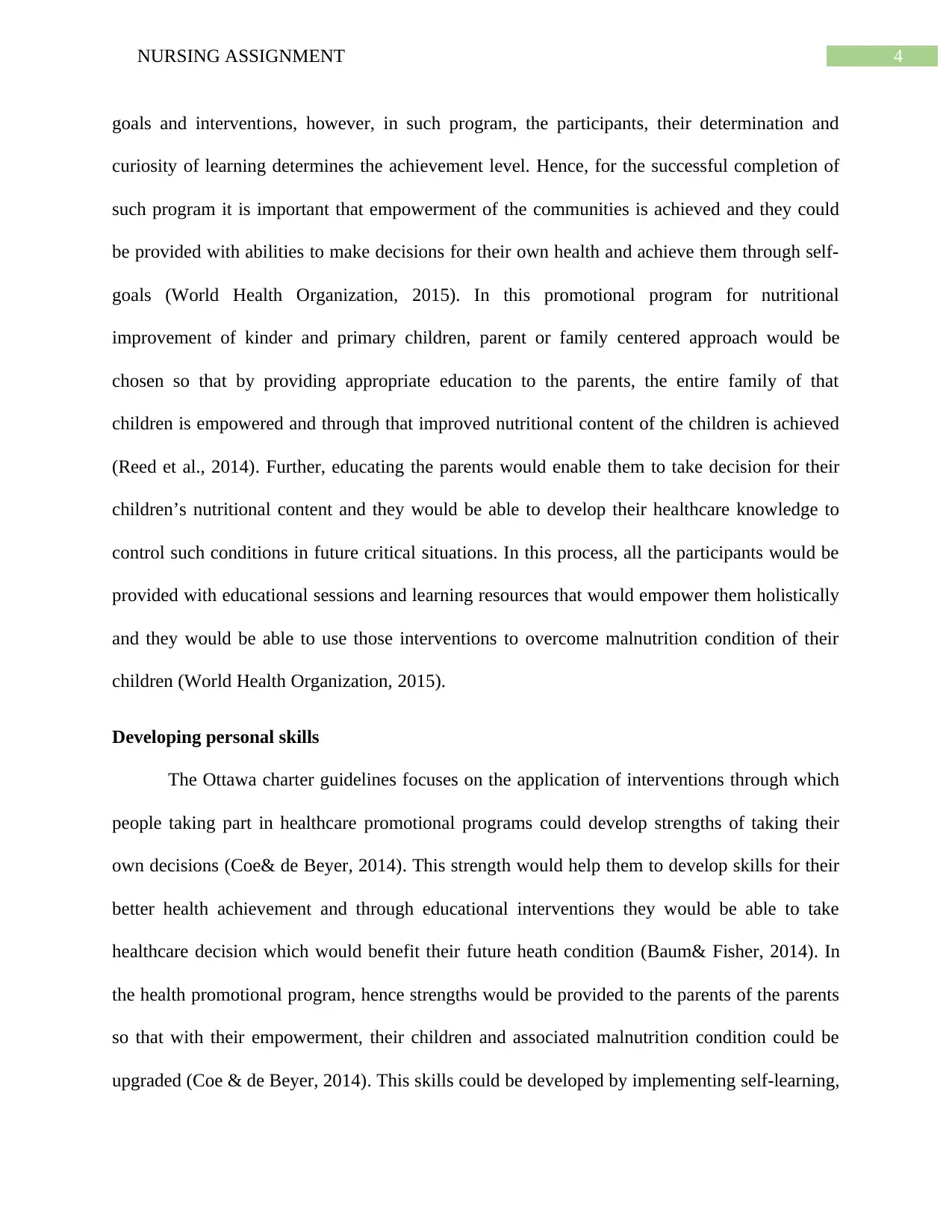
4NURSING ASSIGNMENT
goals and interventions, however, in such program, the participants, their determination and
curiosity of learning determines the achievement level. Hence, for the successful completion of
such program it is important that empowerment of the communities is achieved and they could
be provided with abilities to make decisions for their own health and achieve them through self-
goals (World Health Organization, 2015). In this promotional program for nutritional
improvement of kinder and primary children, parent or family centered approach would be
chosen so that by providing appropriate education to the parents, the entire family of that
children is empowered and through that improved nutritional content of the children is achieved
(Reed et al., 2014). Further, educating the parents would enable them to take decision for their
children’s nutritional content and they would be able to develop their healthcare knowledge to
control such conditions in future critical situations. In this process, all the participants would be
provided with educational sessions and learning resources that would empower them holistically
and they would be able to use those interventions to overcome malnutrition condition of their
children (World Health Organization, 2015).
Developing personal skills
The Ottawa charter guidelines focuses on the application of interventions through which
people taking part in healthcare promotional programs could develop strengths of taking their
own decisions (Coe& de Beyer, 2014). This strength would help them to develop skills for their
better health achievement and through educational interventions they would be able to take
healthcare decision which would benefit their future heath condition (Baum& Fisher, 2014). In
the health promotional program, hence strengths would be provided to the parents of the parents
so that with their empowerment, their children and associated malnutrition condition could be
upgraded (Coe & de Beyer, 2014). This skills could be developed by implementing self-learning,
goals and interventions, however, in such program, the participants, their determination and
curiosity of learning determines the achievement level. Hence, for the successful completion of
such program it is important that empowerment of the communities is achieved and they could
be provided with abilities to make decisions for their own health and achieve them through self-
goals (World Health Organization, 2015). In this promotional program for nutritional
improvement of kinder and primary children, parent or family centered approach would be
chosen so that by providing appropriate education to the parents, the entire family of that
children is empowered and through that improved nutritional content of the children is achieved
(Reed et al., 2014). Further, educating the parents would enable them to take decision for their
children’s nutritional content and they would be able to develop their healthcare knowledge to
control such conditions in future critical situations. In this process, all the participants would be
provided with educational sessions and learning resources that would empower them holistically
and they would be able to use those interventions to overcome malnutrition condition of their
children (World Health Organization, 2015).
Developing personal skills
The Ottawa charter guidelines focuses on the application of interventions through which
people taking part in healthcare promotional programs could develop strengths of taking their
own decisions (Coe& de Beyer, 2014). This strength would help them to develop skills for their
better health achievement and through educational interventions they would be able to take
healthcare decision which would benefit their future heath condition (Baum& Fisher, 2014). In
the health promotional program, hence strengths would be provided to the parents of the parents
so that with their empowerment, their children and associated malnutrition condition could be
upgraded (Coe & de Beyer, 2014). This skills could be developed by implementing self-learning,
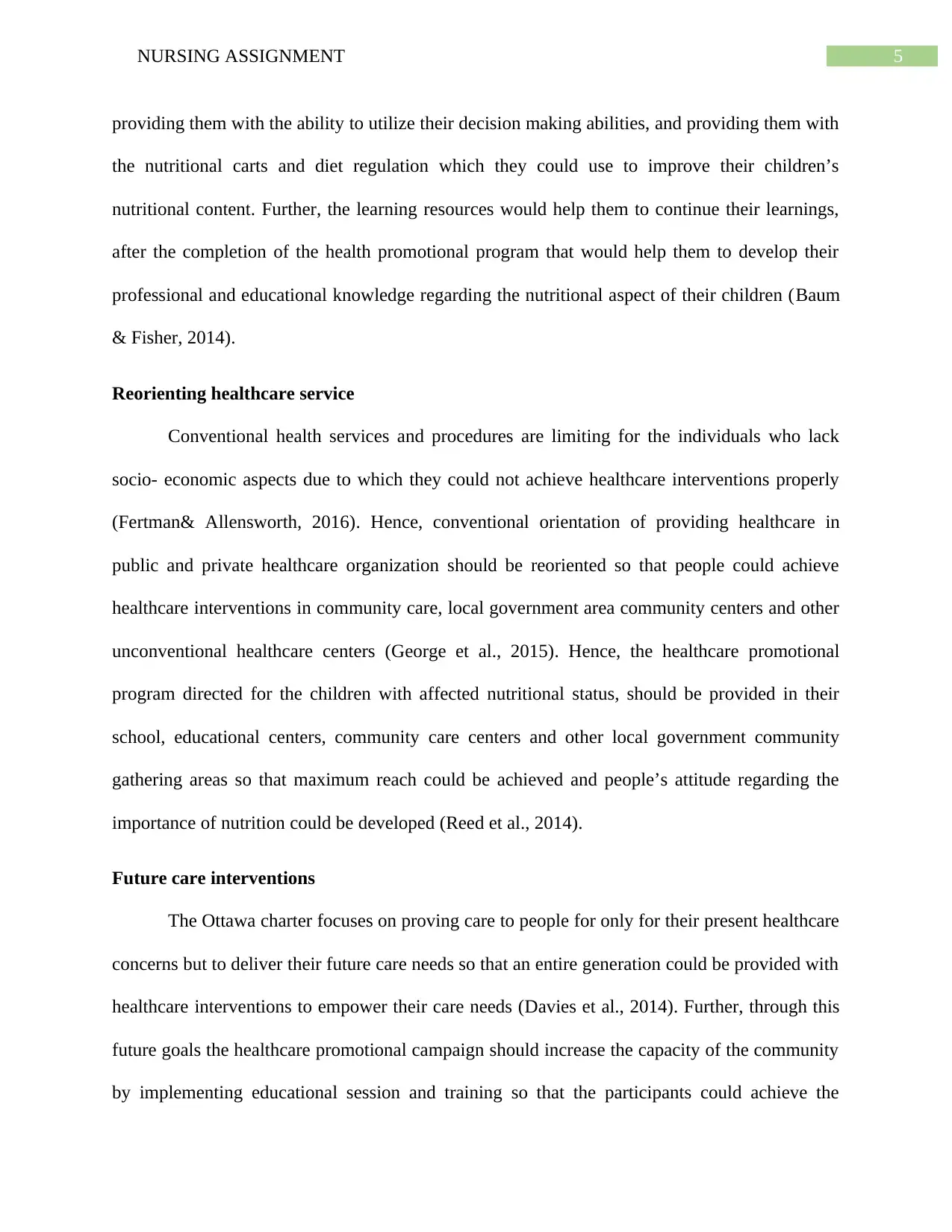
5NURSING ASSIGNMENT
providing them with the ability to utilize their decision making abilities, and providing them with
the nutritional carts and diet regulation which they could use to improve their children’s
nutritional content. Further, the learning resources would help them to continue their learnings,
after the completion of the health promotional program that would help them to develop their
professional and educational knowledge regarding the nutritional aspect of their children (Baum
& Fisher, 2014).
Reorienting healthcare service
Conventional health services and procedures are limiting for the individuals who lack
socio- economic aspects due to which they could not achieve healthcare interventions properly
(Fertman& Allensworth, 2016). Hence, conventional orientation of providing healthcare in
public and private healthcare organization should be reoriented so that people could achieve
healthcare interventions in community care, local government area community centers and other
unconventional healthcare centers (George et al., 2015). Hence, the healthcare promotional
program directed for the children with affected nutritional status, should be provided in their
school, educational centers, community care centers and other local government community
gathering areas so that maximum reach could be achieved and people’s attitude regarding the
importance of nutrition could be developed (Reed et al., 2014).
Future care interventions
The Ottawa charter focuses on proving care to people for only for their present healthcare
concerns but to deliver their future care needs so that an entire generation could be provided with
healthcare interventions to empower their care needs (Davies et al., 2014). Further, through this
future goals the healthcare promotional campaign should increase the capacity of the community
by implementing educational session and training so that the participants could achieve the
providing them with the ability to utilize their decision making abilities, and providing them with
the nutritional carts and diet regulation which they could use to improve their children’s
nutritional content. Further, the learning resources would help them to continue their learnings,
after the completion of the health promotional program that would help them to develop their
professional and educational knowledge regarding the nutritional aspect of their children (Baum
& Fisher, 2014).
Reorienting healthcare service
Conventional health services and procedures are limiting for the individuals who lack
socio- economic aspects due to which they could not achieve healthcare interventions properly
(Fertman& Allensworth, 2016). Hence, conventional orientation of providing healthcare in
public and private healthcare organization should be reoriented so that people could achieve
healthcare interventions in community care, local government area community centers and other
unconventional healthcare centers (George et al., 2015). Hence, the healthcare promotional
program directed for the children with affected nutritional status, should be provided in their
school, educational centers, community care centers and other local government community
gathering areas so that maximum reach could be achieved and people’s attitude regarding the
importance of nutrition could be developed (Reed et al., 2014).
Future care interventions
The Ottawa charter focuses on proving care to people for only for their present healthcare
concerns but to deliver their future care needs so that an entire generation could be provided with
healthcare interventions to empower their care needs (Davies et al., 2014). Further, through this
future goals the healthcare promotional campaign should increase the capacity of the community
by implementing educational session and training so that the participants could achieve the
⊘ This is a preview!⊘
Do you want full access?
Subscribe today to unlock all pages.

Trusted by 1+ million students worldwide

6NURSING ASSIGNMENT
required learning which would help them to control their future critical health situations
(Leischik et al., 2016). Hence, in this care program namely ‘Healthy kids, happy kids’, all the
children and parents would be provided with educational sessions, training for interventions so
that parents could implement them in their home and provide their children with effective
nutritional content so that overall development could be achieved (Davies et al., 2014).
Conclusion
Healthcare promotional events are effective tools using which majority of the community
could be provided with healthcare interventions so that people could achieve their healthcare
goals though effective interventions. Ottawa charter pact, therefore provides guidelines for the
successful implementation of healthcare promotional events as complying with this guideline
could make the care promotional practice effective and accurate for the chosen community. In
this aspect, this paper complied with the six core competencies of the Ottawa charter so that
promotional health program for kids in kinder and primary schools should be able to address the
nutritional demand of the children and empower their children to maintain effective nutritional
activities in Donald (town) of Victoria, Australia. Further, it enhances the capacity of the
children to maintain their nutritional content with strict instruction of their parents. Hence, this
way the healthcare goals of the promotional program would be achieved.
required learning which would help them to control their future critical health situations
(Leischik et al., 2016). Hence, in this care program namely ‘Healthy kids, happy kids’, all the
children and parents would be provided with educational sessions, training for interventions so
that parents could implement them in their home and provide their children with effective
nutritional content so that overall development could be achieved (Davies et al., 2014).
Conclusion
Healthcare promotional events are effective tools using which majority of the community
could be provided with healthcare interventions so that people could achieve their healthcare
goals though effective interventions. Ottawa charter pact, therefore provides guidelines for the
successful implementation of healthcare promotional events as complying with this guideline
could make the care promotional practice effective and accurate for the chosen community. In
this aspect, this paper complied with the six core competencies of the Ottawa charter so that
promotional health program for kids in kinder and primary schools should be able to address the
nutritional demand of the children and empower their children to maintain effective nutritional
activities in Donald (town) of Victoria, Australia. Further, it enhances the capacity of the
children to maintain their nutritional content with strict instruction of their parents. Hence, this
way the healthcare goals of the promotional program would be achieved.
Paraphrase This Document
Need a fresh take? Get an instant paraphrase of this document with our AI Paraphraser

7NURSING ASSIGNMENT
References
Alley, D. E., Asomugha, C. N., Conway, P. H., & Sanghavi, D. M. (2016). Accountable health
communities—addressing social needs through Medicare and Medicaid. N Engl J
Med, 374(1), 8-11. DOI: 10.1056/NEJMp1512532
Baum, F., & Fisher, M. (2014). Why behavioural health promotion endures despite its failure to
reduce health inequities. Sociology of health & illness, 36(2), 213-225.DOI:
https://doi.org/10.1111/1467-9566.12112
Coe, G., & de Beyer, J. (2014). The imperative for health promotion in universal health
coverage. Global Health: Science and Practice, 2(1), 10-22.DOI:
https://doi.org/10.9745/GHSP-D-13-00164
Davies, S. C., Winpenny, E., Ball, S., Fowler, T., Rubin, J., & Nolte, E. (2014). For debate: a
new wave in public health improvement. The Lancet, 384(9957), 1889-1895. DOI:
https://doi.org/10.1016/S0140-6736(13)62341-7
Dodson, S., Good, S., & Osborne, R. (2015). Health literacy toolkit for low and middle-income
countries: a series of information sheets to empower communities and strengthen health
systems.DOI: http://hdl.handle.net/10536/DRO/DU:30074618
Eldredge, L. K. B., Markham, C. M., Ruiter, R. A., Kok, G., Fernandez, M. E., & Parcel, G. S.
(2016). Planning health promotion programs: an intervention mapping approach. John
Wiley & Sons. Retrieved from: https://books.google.co.in/books?
hl=en&lr=&id=UyrdCQAAQBAJ&oi=fnd&pg=PR11&dq=Eldredge,+L.+K.+B.,
+Markham,+C.+M.,+Ruiter,+R.+A.,+Kok,+G.,+Fernandez,+M.+E.,+%26+Parcel,+G.
+S.+(2016).+Planning+health+promotion+programs:
References
Alley, D. E., Asomugha, C. N., Conway, P. H., & Sanghavi, D. M. (2016). Accountable health
communities—addressing social needs through Medicare and Medicaid. N Engl J
Med, 374(1), 8-11. DOI: 10.1056/NEJMp1512532
Baum, F., & Fisher, M. (2014). Why behavioural health promotion endures despite its failure to
reduce health inequities. Sociology of health & illness, 36(2), 213-225.DOI:
https://doi.org/10.1111/1467-9566.12112
Coe, G., & de Beyer, J. (2014). The imperative for health promotion in universal health
coverage. Global Health: Science and Practice, 2(1), 10-22.DOI:
https://doi.org/10.9745/GHSP-D-13-00164
Davies, S. C., Winpenny, E., Ball, S., Fowler, T., Rubin, J., & Nolte, E. (2014). For debate: a
new wave in public health improvement. The Lancet, 384(9957), 1889-1895. DOI:
https://doi.org/10.1016/S0140-6736(13)62341-7
Dodson, S., Good, S., & Osborne, R. (2015). Health literacy toolkit for low and middle-income
countries: a series of information sheets to empower communities and strengthen health
systems.DOI: http://hdl.handle.net/10536/DRO/DU:30074618
Eldredge, L. K. B., Markham, C. M., Ruiter, R. A., Kok, G., Fernandez, M. E., & Parcel, G. S.
(2016). Planning health promotion programs: an intervention mapping approach. John
Wiley & Sons. Retrieved from: https://books.google.co.in/books?
hl=en&lr=&id=UyrdCQAAQBAJ&oi=fnd&pg=PR11&dq=Eldredge,+L.+K.+B.,
+Markham,+C.+M.,+Ruiter,+R.+A.,+Kok,+G.,+Fernandez,+M.+E.,+%26+Parcel,+G.
+S.+(2016).+Planning+health+promotion+programs:
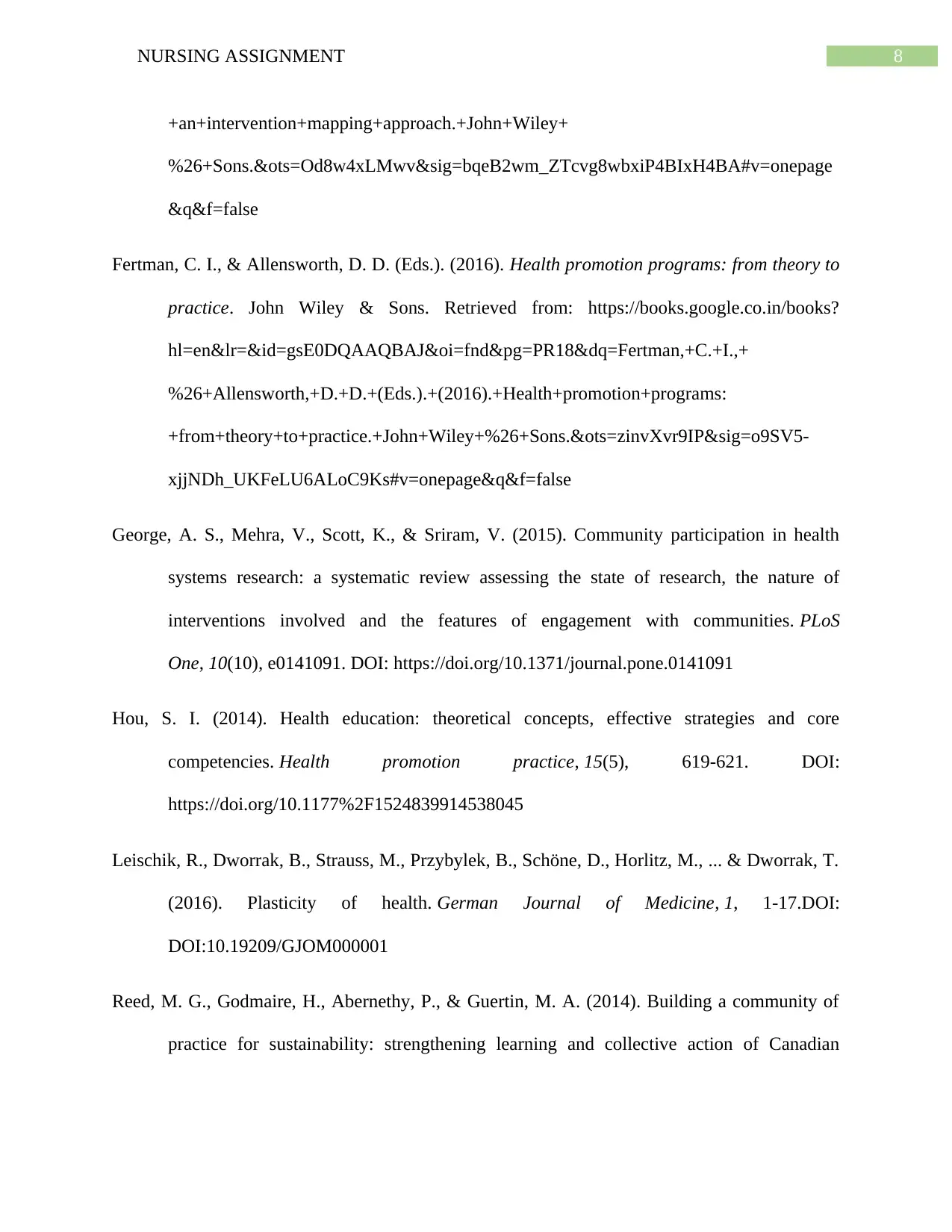
8NURSING ASSIGNMENT
+an+intervention+mapping+approach.+John+Wiley+
%26+Sons.&ots=Od8w4xLMwv&sig=bqeB2wm_ZTcvg8wbxiP4BIxH4BA#v=onepage
&q&f=false
Fertman, C. I., & Allensworth, D. D. (Eds.). (2016). Health promotion programs: from theory to
practice. John Wiley & Sons. Retrieved from: https://books.google.co.in/books?
hl=en&lr=&id=gsE0DQAAQBAJ&oi=fnd&pg=PR18&dq=Fertman,+C.+I.,+
%26+Allensworth,+D.+D.+(Eds.).+(2016).+Health+promotion+programs:
+from+theory+to+practice.+John+Wiley+%26+Sons.&ots=zinvXvr9IP&sig=o9SV5-
xjjNDh_UKFeLU6ALoC9Ks#v=onepage&q&f=false
George, A. S., Mehra, V., Scott, K., & Sriram, V. (2015). Community participation in health
systems research: a systematic review assessing the state of research, the nature of
interventions involved and the features of engagement with communities. PLoS
One, 10(10), e0141091. DOI: https://doi.org/10.1371/journal.pone.0141091
Hou, S. I. (2014). Health education: theoretical concepts, effective strategies and core
competencies. Health promotion practice, 15(5), 619-621. DOI:
https://doi.org/10.1177%2F1524839914538045
Leischik, R., Dworrak, B., Strauss, M., Przybylek, B., Schöne, D., Horlitz, M., ... & Dworrak, T.
(2016). Plasticity of health. German Journal of Medicine, 1, 1-17.DOI:
DOI:10.19209/GJOM000001
Reed, M. G., Godmaire, H., Abernethy, P., & Guertin, M. A. (2014). Building a community of
practice for sustainability: strengthening learning and collective action of Canadian
+an+intervention+mapping+approach.+John+Wiley+
%26+Sons.&ots=Od8w4xLMwv&sig=bqeB2wm_ZTcvg8wbxiP4BIxH4BA#v=onepage
&q&f=false
Fertman, C. I., & Allensworth, D. D. (Eds.). (2016). Health promotion programs: from theory to
practice. John Wiley & Sons. Retrieved from: https://books.google.co.in/books?
hl=en&lr=&id=gsE0DQAAQBAJ&oi=fnd&pg=PR18&dq=Fertman,+C.+I.,+
%26+Allensworth,+D.+D.+(Eds.).+(2016).+Health+promotion+programs:
+from+theory+to+practice.+John+Wiley+%26+Sons.&ots=zinvXvr9IP&sig=o9SV5-
xjjNDh_UKFeLU6ALoC9Ks#v=onepage&q&f=false
George, A. S., Mehra, V., Scott, K., & Sriram, V. (2015). Community participation in health
systems research: a systematic review assessing the state of research, the nature of
interventions involved and the features of engagement with communities. PLoS
One, 10(10), e0141091. DOI: https://doi.org/10.1371/journal.pone.0141091
Hou, S. I. (2014). Health education: theoretical concepts, effective strategies and core
competencies. Health promotion practice, 15(5), 619-621. DOI:
https://doi.org/10.1177%2F1524839914538045
Leischik, R., Dworrak, B., Strauss, M., Przybylek, B., Schöne, D., Horlitz, M., ... & Dworrak, T.
(2016). Plasticity of health. German Journal of Medicine, 1, 1-17.DOI:
DOI:10.19209/GJOM000001
Reed, M. G., Godmaire, H., Abernethy, P., & Guertin, M. A. (2014). Building a community of
practice for sustainability: strengthening learning and collective action of Canadian
⊘ This is a preview!⊘
Do you want full access?
Subscribe today to unlock all pages.

Trusted by 1+ million students worldwide
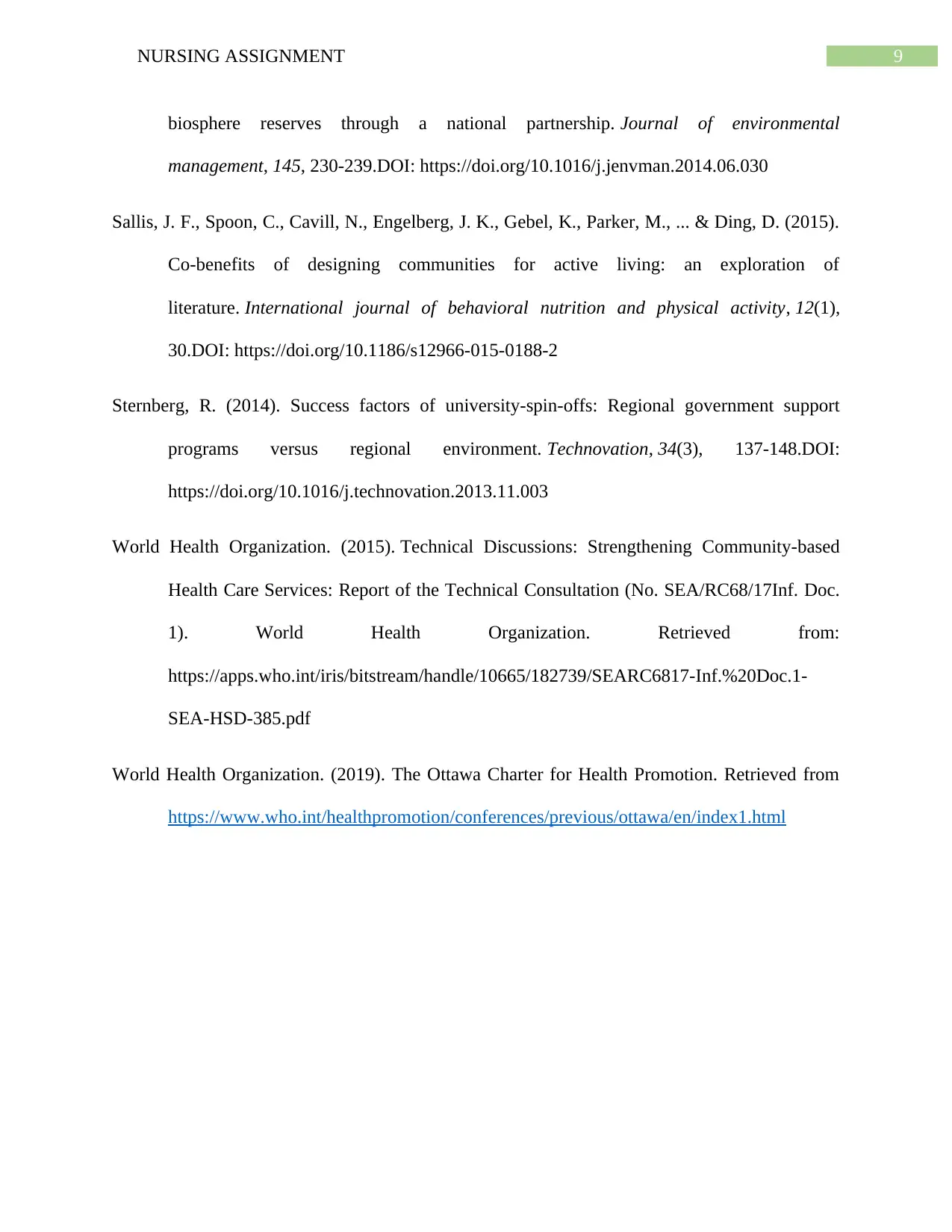
9NURSING ASSIGNMENT
biosphere reserves through a national partnership. Journal of environmental
management, 145, 230-239.DOI: https://doi.org/10.1016/j.jenvman.2014.06.030
Sallis, J. F., Spoon, C., Cavill, N., Engelberg, J. K., Gebel, K., Parker, M., ... & Ding, D. (2015).
Co-benefits of designing communities for active living: an exploration of
literature. International journal of behavioral nutrition and physical activity, 12(1),
30.DOI: https://doi.org/10.1186/s12966-015-0188-2
Sternberg, R. (2014). Success factors of university-spin-offs: Regional government support
programs versus regional environment. Technovation, 34(3), 137-148.DOI:
https://doi.org/10.1016/j.technovation.2013.11.003
World Health Organization. (2015). Technical Discussions: Strengthening Community-based
Health Care Services: Report of the Technical Consultation (No. SEA/RC68/17Inf. Doc.
1). World Health Organization. Retrieved from:
https://apps.who.int/iris/bitstream/handle/10665/182739/SEARC6817-Inf.%20Doc.1-
SEA-HSD-385.pdf
World Health Organization. (2019). The Ottawa Charter for Health Promotion. Retrieved from
https://www.who.int/healthpromotion/conferences/previous/ottawa/en/index1.html
biosphere reserves through a national partnership. Journal of environmental
management, 145, 230-239.DOI: https://doi.org/10.1016/j.jenvman.2014.06.030
Sallis, J. F., Spoon, C., Cavill, N., Engelberg, J. K., Gebel, K., Parker, M., ... & Ding, D. (2015).
Co-benefits of designing communities for active living: an exploration of
literature. International journal of behavioral nutrition and physical activity, 12(1),
30.DOI: https://doi.org/10.1186/s12966-015-0188-2
Sternberg, R. (2014). Success factors of university-spin-offs: Regional government support
programs versus regional environment. Technovation, 34(3), 137-148.DOI:
https://doi.org/10.1016/j.technovation.2013.11.003
World Health Organization. (2015). Technical Discussions: Strengthening Community-based
Health Care Services: Report of the Technical Consultation (No. SEA/RC68/17Inf. Doc.
1). World Health Organization. Retrieved from:
https://apps.who.int/iris/bitstream/handle/10665/182739/SEARC6817-Inf.%20Doc.1-
SEA-HSD-385.pdf
World Health Organization. (2019). The Ottawa Charter for Health Promotion. Retrieved from
https://www.who.int/healthpromotion/conferences/previous/ottawa/en/index1.html
1 out of 10
Related Documents
Your All-in-One AI-Powered Toolkit for Academic Success.
+13062052269
info@desklib.com
Available 24*7 on WhatsApp / Email
![[object Object]](/_next/static/media/star-bottom.7253800d.svg)
Unlock your academic potential
Copyright © 2020–2025 A2Z Services. All Rights Reserved. Developed and managed by ZUCOL.





